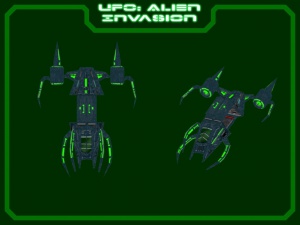Difference between revisions of "Translation:Ufo scout txt/sv"
m (moved UFO/Spejare to Translation:Ufo scout txt/sv: Normalize translation pages) |
(No difference)
|
Latest revision as of 13:14, 2 October 2010
UFOpaedia Entry
Proposal
TO: Base Commander, PHALANX, Atlantic Operations Command
FROM: Cdr. Paul Navarre, R&D: Engineering Division, PHALANX, Atlantic Operations Command
DATE: %02i %s %i
SUB: UFO -- Scout
Commander, we've recovered a new UFO type which is now waiting in our hangar for disassembly. We're ready to start studying and dismantling the craft whenever you say, but we will need some lab time and funding to make a proper assessment of its function and capabilities.
--Cdr. Navarre
Result
TO: Base Commander, PHALANX, Atlantic Operations Command
FROM: Cdr. Paul Navarre, R&D: Engineering Division, PHALANX, Atlantic Operations Command
DATE: %02i %s %i
SUB: Re: UFO -- Scout
Commander, my team and I have finished our analysis of the small UFO we captured. It's a real miracle of engineering, and we're all looking forward to getting a chance to sink our own hooks into all this lovely technology.
The craft's strange construction has raised a lot of questions for us to answer. Much of the design seems to make little sense when viewed from the ground. However, now that we've managed to look 'under the hood' and test the alien hull materials under laboratory conditions, we have gained a far clearer picture of UFO capabilities. I've made a list of our most important discoveries.
- The alien propulsion system is a type of rocket engine unlike any ever built on Earth. It uses direct matter-antimatter annihilation to generate thrust by injecting protons and antiprotons into the reaction chamber, and then channeling this explosive force out the back of the engine. This gives a UFO extreme power and needs no air or other gases to fuel the reaction, allowing it to burn in hard vacuum. There is a highly-advanced cooling system continuously pumping liquid nitrogen through the engine housing in order to keep it cool and reduce the infrared signature. Engine heat is also used to supply the craft's electricity.
- We've found no evidence of landing gear or hover ability in this craft, implying that it isn't meant to land. If it loses both engines, it goes down.
- The fuel tank is very, very small, measured in fractions of a gramme, but even so I nearly had a heart attack when I found out what was in there. The maximum load -- two tenths of a gramme -- could create a blast yield of more than 8 kilotons. By comparison the bomb at Hiroshima was 13 kilotons. Naturally the tank is armoured and buried as deep as possible within the fuselage, and there are mechanical systems present to jettison the tank in an emergency, but they aren't perfect. A direct hit on the tank or the containment system could still cause an explosion. Much of the blast would be contained by the UFO's tough structure, but any explosion represents an extreme hazard to our interceptors. The only saving grace is that antimatter explosions create little to no radioactive fallout.
- The craft is extremely hard to see with our detection equipment. This is largely due to the hull materials which very effectively absorb all kinds of radiation. We've had the most luck with infrared and gamma ray detection, as the antimatter-based engines produce quite a lot of both.
- The slim design (generating poor lift and being difficult to handle in air) is partly due to the heavy weight of the hull materials. Every gramme of excess matter has been stripped, and the craft moves fast enough to need very little wing surface. The material itself is quite astonishing, part metal and part plastic polymer. It functions as a memory alloy, 'remembering' at least two assigned shapes, shrinking into a more compact form when cold but automatically stretching out and assuming a more comfortable flying shape once it heats up. It's far stronger and tougher than anything we've ever known. More research is definitely required.
- We have determined the craft to be unarmed, but it's equipped with what appears to be a large suite of sensors contained in the four protrusions around the cockpit. Curiously, it seems to mount no communications equipment whatsoever, but that would defeat its apparent role as a scout. Your guess is as good as ours, sir.
We have dubbed this class of UFO the 'Scout', as that seems to be its purpose here on Earth. It is used primarily as a reconnaissance unit and vanguard to scout the way for heavier craft. Though unarmed, we should shoot these craft down if we are not otherwise engaged, because anything the aliens are up to is bound to be bad for us.
--Cdr. Navarre
Estimated Scout statistics:
Size: Small (6m x 14m x 3m)
Cruising speed: +/- 1,600 km/h
Top speed: +/- 3,000km/h
Crew capacity: 3 max.
Weapon capacity: None
Research Tree Data
(This information for reference only; do not translate or include in-game.)
Prerequisites: 1 Scout UFO
Opens: Alien Materials UFO -- Fighter UFO -- Harvester Improved UFO Detection
See also Vehicles & UFOs
